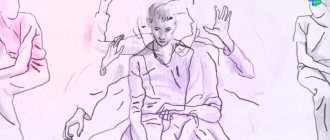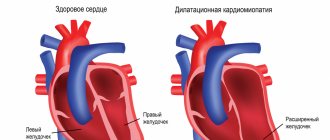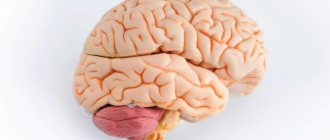Find out more about other diseases starting with the letter “C”: Compression of the brain; Senile chorea; Sensitive ataxia; Serous meningitis; "Rigid person" syndrome; Alien hand syndrome; Restless legs syndrome; Bogorad syndrome; West syndrome; Gaye-Wernicke syndrome; Guillain-Barre syndrome; Piriformis syndrome; Carpal tunnel syndrome; Carotid sinus syndrome; Kleine-Levin syndrome; Klippel-Feil syndrome; Cauda equina syndrome; Crumpy syndrome; Lambert-Eaton syndrome; Landau-Kleffner syndrome.
Term designation
Sensitive ataxia is a disease that is manifested by a violation of the sensory sensation of pressure, vibration responses and body position in space, causing motor disturbances and incoordination. The characteristic symptoms of the anomaly are: a disorder of standard gait and coordination, low blood pressure in the skeletal muscle regions, uncontrolled movements of the distal areas of the arms. Deviations from the norm in medical institutions are identified in the presence of specific neurological data. The main diagnostic methods include the collection of blood cells for biochemical testing, neurophysiological testing, computed tomography or magnetic resonance imaging of the brain or spinal cord, and genetic testing. Neurometabolic techniques are prescribed as therapeutic therapy, since the etiotropic method is not effective. Patients are prescribed anticholinesterase medications, vitamin complexes, ATP, massage sessions, etc.
Cerebellum: features
The cerebellum, like some other elements of the central nervous system, provides the ability to move. In addition to it, cells in muscles, bones, and skin layers are involved. The role of nerves connecting cells is important, and the most significant are the brain and spinal cord. Part of the brain is the cerebellum, located in the back of the skull, approximately at the level where the back of the head is located. The cerebellum contains six peduncles, two hemispheres and a vermis.
Thanks to the work of the hemispheres, a person can maintain balance and move limbs correctly. The worm provides the ability to maintain balance and maintain the adopted posture. When muscle groups tense, the cerebellum receives impulses along the nerves from the cerebral cortex, reads the data, generates impulses - back to the brain and to the muscles through which movement is realized. This entire signal transmission system is a method of coordinating the movements of the human body. With the normal functioning of all the involved elements, a person can move accurately, beautifully, proportionately, and in balance.
Quick Facts
Impaired sensory perception is associated with problems of proprioceptive types of sensitivity, which doctors include:
- A muscle-joint reflex that perceives information about the position of the body in the environment.
- Vibration sensitivity.
- Understanding mass and pressure.
Motor and coordination failures are formed as a result of the absence or lack of kinesthetic information in the central areas of the proprioceptive apparatus, which provides data on muscle contractions. Ataxia of the sensitive type is not capable of developing independently; it manifests itself as a symptom complex in neurological disorders. In different situations, the disease progresses depending on the topical nuances of damage to the proprioceptive nerve channels.
General description of the pathology
The cerebellum is a special structure of the brain located in the posterior cranial fossa of the occipital and temporal lobes. The organ performs one of the main functions - maintaining balance and coordinating movements. It contains about 50% of the brain's neurons. In order to simply stand up or sit down, you need to use many muscles, the cerebellum is responsible for the coordinated work of them.
Cerebellar ataxia is a syndrome related to neurological disorders. The disease occurs quite often and is almost always associated with various injuries and diseases. Recently, specialists most often diagnose a hereditary form of pathology, and in more rare cases, an acquired form.
Main sources of occurrence
The anomaly is associated with a malfunction in the pathways of deep sensory ability. The deviation originates in different areas of the proprioceptive system (on the back of the spinal cord, ganglia, roots, in the medulla oblongata, thalamus and cortex). The disorder is caused by vascular diseases (stroke), tumor formation, cerebral neoplasm, multiple sclerosis, and damage to the spinal cord. In some cases, sensitive ataxia appears as a result of a complication reaction after surgery. Doctors observe the development of the disease in Guillain-Barre syndrome and other types of polyneuropathy (diabetic, alcoholic, infectious-toxic type, etc.). Impaired vibration sensation can provoke symptoms of hereditary abnormalities.
Causes
The likelihood of the disease increasing against the background of traumatic brain injury; chronic infectious processes and their complications; exposure to ionizing radiation; intoxication of the body; birth injuries; hereditary predisposition; bad habits; sedentary lifestyle. The immediate causes of coordination and movement disorders may be:
- brain pathologies;
- cerebellar dysfunction;
- acquired or congenital ischemia (chronic circulatory failure).
Concomitant diseases that can indirectly affect the appearance of ataxia (motor dysfunction) are:
- atrophy of the cerebral cortex;
- hypertension (high blood pressure);
- Cerebral palsy (cerebral palsy);
- dropsy of the brain (hydrocephalus);
- osteochondrosis (spinal disease);
- multiple sclerosis;
- atherosclerosis (chronic artery disease).
Sometimes dizziness and motor dysfunction can be signs of both the syndrome itself and age-related natural disorders of the human musculoskeletal system and vestibular system. In addition, the manifestations of vestibular ataxia are influenced by the general state of health and lifestyle of a person. Therefore, only a specialist can make an accurate diagnosis after diagnostics.
Symptoms of vestibulo-atactic syndrome
Clinical signs of ataxic syndrome are manifested in disruption of the cardiovascular system, motor, and vestibular disorders. Problems arise with cerebral and general blood circulation. The disease is insidious in that its early manifestation for a person can go unnoticed. As a rule, the initial stage of the disease is accompanied by the following symptoms:
- constant headache;
- flickering light, black spots before the eyes;
- dizziness;
- attacks of vomiting, nausea.
As the pathology develops, the patient’s condition worsens, and movement coordination disorders occur:
- spontaneous falls;
- reel;
- noise in ears;
- loss of balance;
- involuntary twitching of the eyelids.
Often the patient develops additional signs of the syndrome:
- insomnia;
- sleep disturbance;
- chronic fatigue;
- low performance;
- daytime sleepiness;
- loss of strength, weakness.
Cephalgic syndrome
A severe headache or cephalgic vestibulo-atactic syndrome brings discomfort to a person’s life. In addition, this illness may be a signal that serious disturbances are occurring in the body’s functioning, such as diseases of the central nervous system (CNS) and brain. Doctors often associate the appearance of cephalalgia with infectious, inflammatory, oncological, neuralgic, vascular diseases and metabolic disorders. Even an incorrect daily routine and bad habits can provoke cephalgic syndrome.
The large number of causes that cause this pathology makes it difficult to diagnose cephalgic syndrome as a symptom of a specific disease. Elimination of a headache should be one of the stages of treating the disease that caused it, and not a separate process. Cephalgia can be triggered by fatigue, nervous tension, or be one of the main signs of vestibulo-atactic syndrome. Therefore, you should take a responsible approach to the occurrence of headaches in order to protect yourself from the development of illnesses with irreversible neuropsychic processes.
Discirculatory encephalopathy with vestibulo-atactic syndrome
Often vestibular ataxia is a harbinger of a serious illness - dyscirculatory encephalopathy. For normal brain function, oxygen is needed, which helps break down glucose and produce energy. With insufficient supply of O2 and toxic effects of substances on brain cells, nerve cells die, causing a disruption in the functioning of the brain. Such disorders are called cerebral encephalopathy. Its most common type is dyscirculatory, which at the third stage of the disease can lead to dementia (dementia).
What is the manifestation of sensitive ataxia?
Deviation from the norm is characterized by the presence of failures in the motor reflex of the patient’s own body. Initially, changes affect gait. The patient places his lower limbs too wide, excessively bends or hyperextends them at the knee and hip, and presses his heel heavily on the ground. In the medical field of neurology, this condition is called “tablet” or “stamping” gait. Patients report to their physicians feelings of walking on cotton wool or falling through while moving. Deficiencies of a proprioceptive nature can be compensated for by an increased degree of visual ability. Patients often walk with their head bent forward to see the floor in front of them. In the absence of visual control, the disease is clearly expressed in the curvature of the gait. As a result of this technique, it is quite difficult for persons diagnosed with sensory ataxia to move at night or with their eyes closed.
The disorder, which has developed in the upper extremities, is characterized by disruptions in voluntary activity and coordination, which cause difficulties in performing daily duties. For example, a patient cannot independently open a door lock, button up a shirt, or drink a cup of tea without spilling a drop. At rest, involuntary movements of the fingers in a chaotic direction are observed, which are similar to athetosis - violent activity caused by a disorder of the subcortical cerebral regions. The difference is the absence of increased symptoms with active gesticulation. Ataxia of a sensitive nature occurs with different clinical pictures, which depend on the level of the lesion. Deviations occurring in the area of the posterior columns of the lumbar and chest provoke the appearance of ataxia exclusively in the legs. The anomaly, which is localized in the neck, causes problems in the upper and lower extremities. Unilateral damage to the proprioceptive zone before the transition of its elements to the other side activates the homolateral form of hemiataxia - symptoms develop in half of the body on the side where the disorder began.
Pathogenesis
Sensitive ataxia is caused by damage to fibers that are part of the peripheral nerves, dorsal roots and posterior columns of the spinal cord, as well as the medial lemniscus. These fibers carry proprioceptive impulses (contain information about the position of body parts and their movement) from the receptors to the cerebral cortex.
Articular-muscular sensation is provided by the receptor apparatus, which is represented by Pacinian corpuscles (non-encapsulated nerve endings located in the joint capsules, ligaments, muscles and periosteum).
Impulses from the receptors travel along the processes of first-order sensory neurons (thick myelinated type A fibers), which enter the posterior horn of the spinal cord, and then, without crossing, into the posterior columns.
The fibers running as part of these pathways form synapses with second-order sensory neurons, which form the nuclei of the thin and wedge-shaped fasciculi in the lower part of the medulla oblongata.
The processes of second-order neurons cross, after which, as part of the medial loop, they rise to the ventral posterior nucleus of the thalamus.
In the ventral posterior nucleus of the thalamus there are third-order sensory neurons associated with the parietal lobe cortex.
Diagnostic measures
The disease can be easily identified through various types of examination techniques. Neurologists observe muscle hypotonia, which appears in extensor and flexion reflexes, inhibition of deep types of sensitivity. When testing the patient according to Romberg standards, the patient is diagnosed with staggering, which increases its activity when the eyes are closed. When it is necessary to stretch your arms forward, uncontrolled movements appear. Individuals diagnosed with sensory ataxia have complaints about coordination abilities: the inability to place a finger on the tip of the nose or place the heel of the left foot to the knee of the right. An abnormal gait of the “table” type is noted. The neurological picture is presented along with deficits and cerebral manifestations. The main task of doctors when examining a patient’s condition is to correctly distinguish sensitive ataxia from other types. The main factor is an increase in symptoms when the eyelids close. Instrumental tests help identify the source of the disease. For diagnosis, doctors prescribe:
- Donation of blood cells for biochemical analysis.
- Electroencephalogram.
- MRI scan of the brain.
- Computed tomography of the spine.
- Electroneurography.
- Assessment of evoked potentials.
- Electromyography.
In cases where the anomaly may be hereditary, the attending physician will prescribe a consultation with a geneticist and DNA testing and genealogical research.
Types of disease
Sensitive is a subtype of the disease in which the nerves are affected, which is why a person who is in the dark or closes his eyes quickly loses his balance.
Ataxia is a disease that causes increased sensitivity to vibration. The patient can be noticed by his unsteady gait. Usually people spread their legs quite wide apart, as if they are slightly drunk. Cerebellar ataxia is a disease in which gait and speech are distorted, and the patient suffers from tremors. If it is necessary to change position, a person often loses his balance. When making a purposeful movement, it is also difficult to maintain balance. The acute form of the disease can be provoked by toxic and even medications. In some cases, the disease is caused by viral encephalitis. If there are abscess processes in the cerebellum, they can also provoke such a problem. There are cases when this form of the disease appeared in childhood in those who had chickenpox.
Methods of treatment and further prognosis for the patient
Sensitive ataxia is treated using an etiotropic or symptomatic approach. The first step to rid the patient of disorders is to stop the deviation from the norm. In the case of an infectious pathogen, the prescription of pharmacological components of an antibacterial type will be required; in case of vascular failures, a vasoactive or hemostatic method of treatment will be prescribed. A patient diagnosed with funicular myelosis will need to take a B vitamin in a certain dosage. There is a possibility of diagnosing a neoplasm. In this situation, the patient will be offered surgery to remove the tumor. Symptomatic therapy is aimed at supporting stable metabolic rates in the nervous tissue to increase the degree of resistance to the development of abnormal deformations and recovery function.
The neurometabolic course of treatment includes the administration of ATP, medications such as galantamine and vitamin complexes. In addition, the doctor prescribes visits to therapeutic exercises and massage sessions. Exercise therapy is aimed at improving the coordination of motor abilities through training. Combining exercises with massage significantly strengthens the muscle department.
The further prognosis of doctors is positive when doctors manage to promptly eliminate the sources of development of the abnormal reaction and completely restore the affected area of the proprioceptive region. For patients with a hereditary type of disorder, the formation of tumors and the formation of persistent degeneration processes, the prognosis is negative. In such situations, therapeutic therapy includes inhibition of the development of the disease and effective training of the patient’s motor abilities.
What does modern medicine offer?
Treatment for impaired cerebellar function is carried out by a specialist - a neurologist. Its main task is to establish the cause of ataxia and eliminate it. A biochemical blood test will confirm or exclude the presence of a bacterial or viral infection. In accordance with this, appropriate antiviral drugs and antibiotics can be prescribed.
Treatment of pathology of the vascular system will require the use of angioprotectors. Often the cerebellar disorder is hereditary. In this case, the patient will be prescribed drugs that improve metabolic processes.
To improve trophic processes in the brain, serious medications such as Pantogam, Nootropil, Vinpocetine and others will be required.
Surgery may be required only if an operable malignant brain tumor is detected. If the cause of impaired motor coordination is severe intoxication, then adsorbents and absorbents will be required.
As an addition to therapy, the doctor may prescribe a homeopathic remedy. And to restore muscle tone, it is recommended to engage in physical therapy daily.
Self-treatment of such a complex disease can lead to serious consequences for the patient. In view of this, you should not experiment with drugs and hope that self-medication will give good results. Only a competent neurologist will be able to formulate the correct comprehensive treatment.
1. Anatomical features 2. Causes of pathology 3. How the syndrome manifests itself 4. Diagnosis 5. Treatment
Making a neurological diagnosis involves not only identifying the nosology of the disease, but also determining the location of damage to the nervous system. In many ways, it is topical diagnosis that determines the treatment and prognosis of the disease. The localization of the lesion can be clarified if there are specific symptom complexes in the clinical picture of the disease, indicating the involvement of certain brain structures in the pathological process. One of the manifestations of the disease that allows us to establish a topical diagnosis is vestibulo-atactic syndrome.
Diagnostics
When diagnosing ataxia, the following methods are used:
- MRI of the brain (detects atrophy of the brain stems and spinal cord, the upper parts of the vermis);
- electroencephalography of the brain (diagnoses reduction of alpha rhythm, diffuse theta and delta activity);
- electromyography (reveals axonal demyelinating damage to sensory fibers of peripheral nerves);
- DNA diagnostics (used to determine hereditary types of ataxia). By conducting indirect DNA diagnostics, doctors determine whether the ataxia pathogen can be inherited by other children in the family;
- magnetic resonance angiography (allows you to assess the integrity and patency in the cranial cavity and identify brain tumors).
Additional diagnostic procedures include consultation with a neurologist, ophthalmologist, and psychiatrist. Laboratory diagnostics for ataxia show a violation of amino acid metabolism - a reduced concentration of alanine and leucine, a decrease in their excretion in the urine.
Since the etiology of this disease involves a fairly wide range of diseases and its congenital nature cannot be ruled out, diagnosing the disease involves consulting the following specialists:
- neurosurgeon;
- neurologist;
- traumatologist;
- oncologist;
- endocrinologist
The diagnostic program may include the following activities:
- spinal puncture and cerebrospinal fluid analysis;
- functional tests;
- CT and MRI of the brain;
- Dopplerography of the brain;
- electronystagmography;
- PCR studies;
- MSCT;
- DNA diagnostics.
In addition, genetic counseling may be needed.
Due to the fact that the etymology of cerebellar pathologies is very diverse, diagnosis is carried out by several specialists with a narrow focus, namely a traumatologist, neurosurgeon, oncologist, geneticist, and endocrinologist. A thorough neurological examination allows not only to determine the cerebellar nature of the ataxia, but also to identify approximately the affected area.
In order to exclude vestibular disorder, it is necessary to conduct a study of the vestibular analyzer. A neurologist may prescribe stabilography, vestibulometry, and electronystagmography. If there is a suspicion that ataxia has arisen as a result of an infectious lesion, a blood sterility test or PCR test is required.
DNA testing and genetic analysis can detect the hereditary nature of ataxia in the cerebellum. The treatment is presented below.
When conducting a full range of examinations, making a diagnosis does not cause difficulties.
A functional test, assessment of tendon reflexes, and blood and cerebrospinal fluid testing are required.
A computed tomography and ultrasound scan of the brain is prescribed, and an anamnesis is collected.









